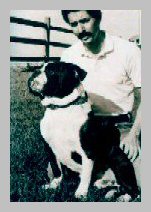 |
 |
The Creator
In 1971, I started this project of breeding a dog with the looks of the 18th century Bulldog. I had become disenchanted with English Bulldogs, due to breeding and breathing problems. I discovered that they didn't look like their ancestors, who were healthier and less extreme. I found that bull and bear-bating had been very widespread for hundreds of years. Extreme cruelty to animals was inherent in baiting sports. This cruelty was abhorrent to me, but I was fascinated by the great tenacity and courage of the over- matched underdog. I was also drawn to the Bulldog because of his fierce appearance. A modern protection dog, which looks really tough, will repulse an assailant without having a bite. This is the most desirable end to a confrontation. I couldn't find a reliable source for old style Bulldogs, and set about the daunting task of breeding back. I call the breed the Olde English Bulldogge.
Research has been critical in developing a standard. I have period statues, paintings, prints, and all the important older dog looks. I found that Bulldog sizes varied during different periods, due to changes in the way the baits were staged. Like all old working breeds, Bulldogs were not bred to a strict standard. Their distinctive body, head, and temperament, were dictated instead by their work.
I do not want the temperament of the original Bulldog. My dogs must be very loving. They must have courage and determination, without being overly aggressive. I've found that I can't count on buyers to get their dogs under good obedience control. If I have to make a mistake, it must be on the friendly side, and if someone wants their dog to be sharper, all it takes is bit of training. I'd rather teach a friendly dog to bite, then vice versa.
I'm using a line-breeding scheme, developed for cattle at Ohio State University. You start with 3 unrelated dogs, two males and one female. Female pups from the first cross are bred to the second male. From this point, females are bred back to uncles, each generation. I have 2 unrelated schemes started, so future outcrosses will be possible. I've used breeds that all have old Bulldog in their background. My dogs are half English Bulldog, and the other half Bullmastiff, Pit Bull, and American Bulldog. The process if getting the dogs to match the old depictions is actually rapid due to the breeds used, and a dogs' short gestation period. I try to get on to the next generation as quickly as possible, to make genetic progress and get consistent results. I'm up to the eight and ninth generations on the two lines, at the time of this printing in 1995.
My dogs can now breath. They will never be like hounds, able to run for miles during the hottest weather of summer, but they're three times better than the restricted modern Bulldog. Cesarean section births are not necessary. Artificial insemination, due to male ineptness and lack of drive, has been replaced by natural ties. Life span in over eleven years. All breeding stock have had hip x-rays. No dog with bad hips is bred. I'm now achieving my goal of producing a Bulldog with the health and temperament to be able to serve people, instead of forcing people to serve him.
The Olde English Bulldogge has met the astringent requirements for inclusion in "The Rare Breed Handbook" and dog show judges can find the standard there. Various registries have recognized the breed, but the most important registration is with the Olde English Bulldogge Association (O.E.B.A.). People are selling fakes. The dogs must have O.E.B.A. papers to be genuine Olde English Bulldogges.
| |
|



|